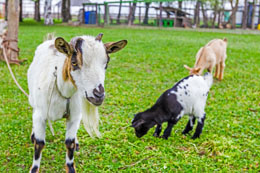 It may come across as a challenging exercise, but goat breeding is very easy if you get the basics right. And considering the advantages it has, it’s worth putting in all the efforts.
It may come across as a challenging exercise, but goat breeding is very easy if you get the basics right. And considering the advantages it has, it’s worth putting in all the efforts.
Goat farming is a common practice, which is adopted for production of milk and meat. It requires minimal investment as compared to rearing of other animals. Being a hardy animal, goat is also considered the best choice in dry and undulating lands, where rearing of cattle is not possible. Owing to these advantages, goats have become quite popular among farmers, who keep them as livestock.
Goat Breeding at a Glance
Proper planning and understanding are the prerequisites of this process. There is no room for negligence in any of the steps involved. It begins with the identification of breeds with preferable qualities. Today, we have various types of improved goat breeds, which are developed to get desired qualities. The pygmy goat, for instance, is a smaller version, commonly reared by hobbyists, while the Boer and Cashmere goats are maintained as livestock for meat and cashmere, respectively.
Breed Identification
First of all, analyze the temperament and bloodlines of your goat. This will help you identify the type of breed that you own and also, determine whether it can be bred successfully or not. Based on which breed you have, you need to find a biologically compatible buck for your doe. In case you have any doubt, take the help of a professional goat breeder.
Age Factor
On an average, a doe attains sexual maturity after one year. By this time, it’s body becomes fully mature to complete the gestation period and give birth to young ones. It is not unusual for a 2-month old doe to become pregnant. But, make sure your goat reaches the ideal breeding age. If you are rearing both doe and buck, make it a point to keep them separate till the ideal breeding period arrives.
Preparing your Doe
In addition to breeding at the right age, another important aspect is to maintain the doe’s health. Feeding your goat regularly with grain, hay, and nutritional supplements will help in keeping your goat fit (about 75 lbs weight) for pregnancy. Proceed with the necessary medical checkups and follow the veterinarian’s advice about changing diet, delivering booster medication, and deworming procedures.
Finding Compatible Buck
Finding a buck that is biologically similar to your doe is not very easy. So, you need to plan well in advance and search for a compatible male goat. In order to get improved offspring with desired traits from the parents, inquire about the various breeds that are compatible with your doe. That way, you can expect a hybrid version with varied traits.
Breeding Types
Based on the availability of buck in your area, you can select natural goat breeding. Either you can borrow the buck for some days, or you can choose the other way round and send your doe for breeding. For both these options, you might have to pay charges for hiring the buck, or additional fee, if you are boarding your doe. Nevertheless, if there are no compatible male goats around, the only option left is artificial insemination.
Selecting Breeding Option
As far as success and affordability are concerned, natural breeding with a buck is a better alternative. Artificial breeding is not just expensive, but also has a low success rate. So, decide the method of fertilization before fall arrives, or the doe enters estrus (heat cycle). Signs of estrus are tail wagging, uneasiness, change in appetite, bleating, and vaginal discharge.
Breeding Season
When fall arrives, or during the breeding season, a doe becomes heated frequently, at an interval of about 18 – 22 days between two heat cycles. It is best to undertake breeding in the early stages for good pregnancy outcomes. Since ovulation takes place within ½ – 1½ days after estrus, delay in breeding reduces the possibility of successful fertilization.
Gestation Period
After fertilization, the doe will enter the gestation period that lasts for 5 months. Take extra care of the doe’s diet and health, which are crucial for both the mother and unborn baby. Count the days and be prepared with the kidding kit. Most likely, your doe will give birth to one or two young ones.
With basic understanding of goat breeding and their maintenance, raising them for profit becomes reliable and easier for small-scale farmers. All the products are usable, right from milk and meat to their skin and feces. No wonder, goat was one of the earliest animals domesticated by man!











RSS